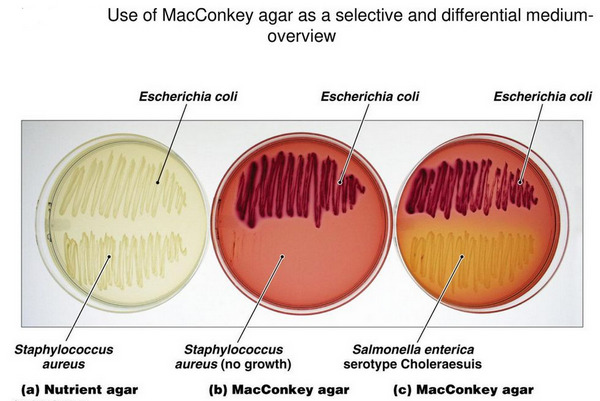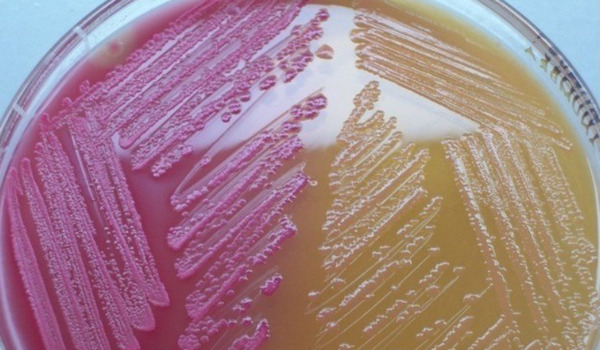MacConkey Agar
Last reviewed by Editorial Team on February 8th, 2019.
A MacConkey Agar is a medium that isolates and differentiates gram-negative as well as enteric bacilli. They are classified or differentiated based on their lactose-fermenting ability.
MacConkey Agar was the very first solid differential media formulated in the 20th century by Alfred Theodore MacConkey. It is both a differential and selective media. (1, 2)

Image 1: The components of MacConkey agar.
Picture Source: image.slidesharecdn.com
What is the content of MacConkey Agar?
- Bile salts (inhibit gram-positive bacteria)
- Peptone
- Neutral red dye (the dye turns into pink when the bacteria are lactose fermenting)
- Lactose
- Proteose peptone (3)
- Sodium chloride
- Crystal violet dye (inhibits the growth of some gram-positive bacteria)
- Agar
- Water

Picture 2: MacConkey agar helps in differentiating lactose fermenting and non-lactose fermenting organisms.
Photo Source: microbiologyinfo.com
What are the uses of MacConkey Agar?
- It helps distinguish gram-negative bacteria that have the ability to ferment sugar lactose from gram-negative bacteria that cannot ferment sugar lactose.
- It isolates gram-negative enteric bacteria.
- It isolates coliforms and intestinal pathogens that might be present in water, biological specimens, and dairy products. (2, 3, 4)

Photo 3: A MacConkey agar; both a selective and differential medium.
Image Source: slideplayer.com

Image 4: Colonies are formed in a MacConkey Agar.
Picture Source: assets.thermofisher.com
What is the principle of MacConkey Agar?
The primary principle of MacConkey agar is to isolate and differentiate lactose-fermenting and lactose non-fermenting gram-negative bacteria.
The growth of microorganisms is possible because of pancreatic digest of gelatin and peptones, which serve as the vitamins, nitrogenous factor, and essential nutrients for the microbes.
The fermentable source of carbohydrate is lactose monohydrate which has a direct attribute to bile salts and crystal violet and they inhibit gram-positive bacteria.
To maintain the osmotic balance of the medium a sodium chloride is used. A pH indicator neutral red turns red when the pH level is below 6.8.
However, if the pH is greater than 6.8 neutral red turns to colorless. Agar serves as the solidifying agent. (4, 5, 6)
How is MacConkey agar test performed?
- A dehydrated medium should be suspended in a purified or distilled water.
- Dissolve the medium by bringing to boil the medium suspended in water.
- Autoclave at 121 degree Celsius for about 15 minutes
- Allow to cool until such time that the temperature reaches 45 to 50 degrees Celsius.
- Pour the mixture into the sterile petri plate. Make sure you mix well the medium before transferring to the petri plate. (3, 6, 7)

Picture 5: MacConkey agar; the one on the left turned pink which means that it is positive for lactose-fermentation while the one on the right is colorless or transparent indicating that it is lactose non-fermenting.
Photo Source: i1.wp.com/microbeonline.com
MacConkey Agar Result
Microorganisms that are lactose-fermenting turn red or pink in color when surrounded by acid precipitated bile. Examples of lactose fermenting bacteria are E. coli, Enterobacter, and Klebsiella.
These strains produce acid that can significantly lower the pH level, which makes the appearance of the medium pink or red. The surrounding of the colony becomes hazy primarily because of the bile salt precipitate.
On the other hand, lactose non-fermenting bacteria are colorless or transparent and you will notice that the appearance of the medium is not altered.
Examples of lactose non-fermenting microorganisms are Proteus species, Salmonella, Pseudomonas aeruginosa, Yersinia, and Shigella. (3, 7, 8, 9)
What to keep in mind?
Some strain of bacteria ferments lactose slowly such as Citrobacter and Serratial. Some produce colonies of mucoid that appear sticky.
This is because of the organism’s ability to produce a capsule made from lactose sugar in the agar.
Examples are Enterobacter and Klebsiella.
MacConkey Agar Variant
Aside from the usual MacConkey agar, the procedure can be modified by adding selective agents.
An example is a sorbitol MacConkey agar to isolate and differentiate enterohemorrhagic E. coli serotype E. coli O157:H7. A colorless circular colony is present indicating that the microorganism is non-sorbitol fermenting. (1, 6, 10)
Are there any limitations?
- A MacConkey agar only gives presumptive identification of the organism. For final identification, an additional test should be performed such as bacterial culture.
- There are strains of bacteria that grow poorly while others fail to grow on the medium.
- The growth and recovery of some strain of gram-negative bacilli can be reduced significantly if the MacConkey agar plate is exposed to increase carbon dioxide during the incubation period.
- Some Proteus strain swam on the medium.
- A serial inoculation in a mixed flora sample is a must to ensure adequate isolation of samples.
- The medium in the agar should be melted only once before use. It should not be reheated numerous times as it could lead to an inaccurate result. (2, 5, 8)
A MacConkey agar is both a selective and differential medium used to isolate and differentiate gram-negative bacteria, especially the members of Enterobacteriaceae family.
It differentiates lactose fermenting gram negative bacteria as well as organisms that ferment sugars other than lactose.
The same medium is used to isolate and detect coliforms and intestinal pathogens that are might present in the water, urine, stool, and other materials.
References:
- https://en.wikipedia.org/wiki/MacConkey_agar
- https://microbiologyinfo.com/macconkey-agar-composition-principle-uses-preparation-and-colony-morphology/
- https://microbeonline.com/macconkey-agar-mac-composition-preparation-uses-and-colony-characteristics/
- http://iws2.collin.edu/dcain/CCCCD%20Micro/macconkeyagar.htm
- http://www.asmscience.org/content/education/protocol/protocol.2855
- https://www.teknova.com/category-s/504.htm
- https://catalog.hardydiagnostics.com/cp_prod/Content/hugo/MacConkeyAgar.htm
- https://www.sciencedirect.com/topics/immunology-and-microbiology/macconkey-agar
- http://foodsafety.neogen.com/en/macconkey-agar
- https://www.sigmaaldrich.com/catalog/product/sigma/m7408?lang=en®ion=PH
Similar Posts:
- Indole Test
- What is Gram Stain Test – Staining Procedure, Principle and Results
- Oxidase Test
- IMViC Test
- Catalase Test
